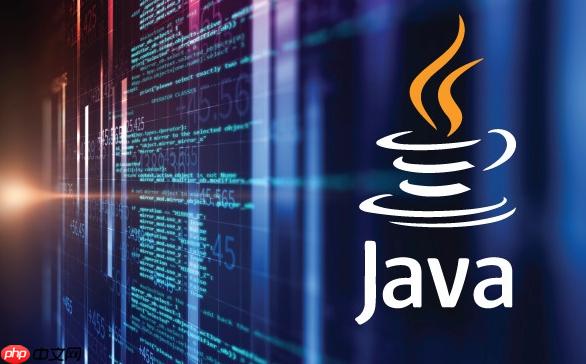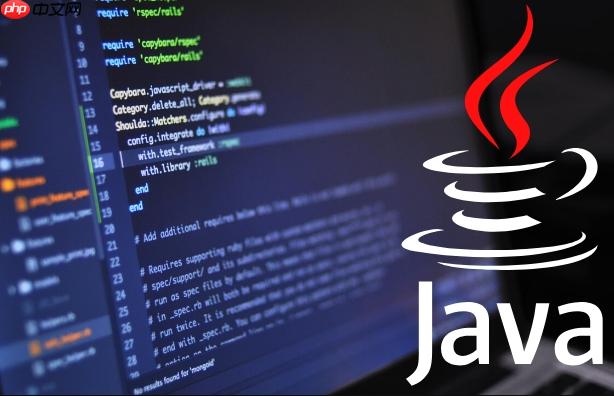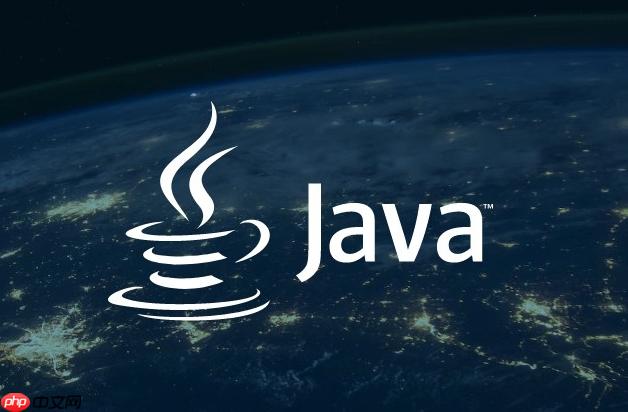java 8 日期时间 api 提供了 localdate、localtime 和 localdatetime 三个核心类,分别用于表示仅日期、仅时间和日期时间组合。1. localdate 表示如“2023-10-27”的日期,不含时间与时区;2. localtime 表示如“10:30:00”的时间,不含日期与时区;3. localdatetime 表示如“2023-10-27t10:30:00”的日期和时间,仍不包含时区信息。这些类均不可变,保障了线程安全。创建可通过 now() 获取当前值或 of() 指定具体值,格式化使用 datetimeformatter,支持预定义与自定义模式。日期计算通过 plus 或 minus 方法实现,返回新实例,也可用 period 和 duration 表示时间段。时区处理由 zoneddatetime(含完整时区规则)和 offsetdatetime(含 utc 偏移)负责。与旧 api 的转换通过 toinstant、atzone 等方法完成。最佳实践包括始终使用不可变类、选择合适类型、使用格式化工具、注意时区影响并避免使用旧类,同时谨记操作后需重新赋值以避免错误。

Java 8 引入的日期时间 API 彻底改变了我们在 Java 中处理日期和时间的方式。它解决了 java.util.Date 和 java.util.Calendar 类中存在的许多问题,提供了更清晰、更易于使用且线程安全的 API。本文将深入探讨 Java 8 日期时间 API 的各个方面,并提供清晰的示例,帮助你全面掌握它。

LocalDateTime、LocalDate 和 LocalTime 的区别是什么?
Java 8 日期时间 API 提供了三个核心类:LocalDateTime、LocalDate 和 LocalTime。它们之间的区别在于它们表示的时间信息的完整性。
立即学习“Java免费学习笔记(深入)”;

LocalDate: 仅表示日期,不包含时间和时区信息。例如:2023-10-27。LocalTime: 仅表示时间,不包含日期和时区信息。例如:10:30:00。LocalDateTime: 表示日期和时间,但不包含时区信息。例如:2023-10-27T10:30:00。选择哪个类取决于你的具体需求。如果只需要日期,则使用 LocalDate。如果只需要时间,则使用 LocalTime。如果需要日期和时间,则使用 LocalDateTime。 重要的是,这些类都是不可变的,这意味着一旦创建,它们的值就不能被修改。每次操作都会返回一个新的实例。这避免了并发问题,因为多个线程可以安全地访问和操作这些对象。
如何创建和格式化日期和时间?

创建日期和时间对象非常简单。你可以使用 now() 方法获取当前日期和时间,或者使用 of() 方法创建指定日期和时间的对象。
// 获取当前日期
LocalDate today = LocalDate.now();
System.out.println("Today's date: " + today);
// 获取当前时间
LocalTime now = LocalTime.now();
System.out.println("Current time: " + now);
// 获取当前日期和时间
LocalDateTime nowDateTime = LocalDateTime.now();
System.out.println("Current date and time: " + nowDateTime);
// 创建指定日期
LocalDate specificDate = LocalDate.of(2024, 1, 1);
System.out.println("Specific date: " + specificDate);
// 创建指定时间
LocalTime specificTime = LocalTime.of(14, 30, 0);
System.out.println("Specific time: " + specificTime);
// 创建指定日期和时间
LocalDateTime specificDateTime = LocalDateTime.of(2024, 1, 1, 14, 30, 0);
System.out.println("Specific date and time: " + specificDateTime);格式化日期和时间可以使用 DateTimeFormatter 类。DateTimeFormatter 提供了多种预定义的格式,也可以自定义格式。
// 使用预定义格式
DateTimeFormatter dateFormatter = DateTimeFormatter.ISO_DATE;
System.out.println("Formatted date (ISO_DATE): " + today.format(dateFormatter));
// 使用自定义格式
DateTimeFormatter customFormatter = DateTimeFormatter.ofPattern("yyyy/MM/dd HH:mm:ss");
System.out.println("Formatted date and time (custom): " + nowDateTime.format(customFormatter));DateTimeFormatter 还有一个 withLocale() 方法,可以指定不同的 Locale,从而根据不同的地区习惯进行格式化。
如何进行日期和时间的计算?
Java 8 日期时间 API 提供了丰富的计算方法,可以方便地进行日期和时间的加减操作。这些方法都返回一个新的对象,而不是修改原始对象。
LocalDate tomorrow = today.plusDays(1);
System.out.println("Tomorrow: " + tomorrow);
LocalDate lastWeek = today.minusWeeks(1);
System.out.println("Last week: " + lastWeek);
LocalTime later = now.plusHours(2);
System.out.println("2 hours later: " + later);
LocalDateTime nextMonth = nowDateTime.plusMonths(1);
System.out.println("Next month: " + nextMonth);除了加减操作,还可以使用 Period 和 Duration 类来表示时间段。
// 计算两个日期之间的天数
LocalDate date1 = LocalDate.of(2023, 1, 1);
LocalDate date2 = LocalDate.of(2023, 10, 27);
Period period = Period.between(date1, date2);
System.out.println("Days between date1 and date2: " + period.getDays());
// 计算两个时间之间的小时数
LocalTime time1 = LocalTime.of(10, 0, 0);
LocalTime time2 = LocalTime.of(12, 30, 0);
Duration duration = Duration.between(time1, time2);
System.out.println("Hours between time1 and time2: " + duration.toHours());时区处理:ZonedDateTime 和 OffsetDateTime 的使用
Java 8 日期时间 API 提供了 ZonedDateTime 和 OffsetDateTime 类来处理时区。ZonedDateTime 包含了时区信息,而 OffsetDateTime 包含了与 UTC 的偏移量。
// 获取当前时区的日期和时间
ZonedDateTime zonedDateTime = ZonedDateTime.now();
System.out.println("Current date and time with time zone: " + zonedDateTime);
// 指定时区
ZoneId zoneId = ZoneId.of("America/Los_Angeles");
ZonedDateTime losAngelesTime = ZonedDateTime.now(zoneId);
System.out.println("Current date and time in Los Angeles: " + losAngelesTime);
// 获取当前日期和时间与 UTC 的偏移量
OffsetDateTime offsetDateTime = OffsetDateTime.now();
System.out.println("Current date and time with offset: " + offsetDateTime);ZonedDateTime 更适合表示具有特定时区规则的日期和时间,例如会议时间。OffsetDateTime 更适合存储日期和时间,以及与 UTC 的偏移量,例如数据库中的时间戳。
与旧 API 的兼容性:Date 和 Calendar 的转换
虽然 Java 8 日期时间 API 提供了更好的替代方案,但在某些情况下,你可能需要与旧的 java.util.Date 和 java.util.Calendar 类进行交互。Java 8 提供了方便的方法来进行转换。
// Date 转换为 LocalDate
Date date = new Date();
LocalDate localDate = date.toInstant().atZone(ZoneId.systemDefault()).toLocalDate();
System.out.println("Date to LocalDate: " + localDate);
// LocalDate 转换为 Date
LocalDate localDate2 = LocalDate.now();
Date date2 = Date.from(localDate2.atStartOfDay(ZoneId.systemDefault()).toInstant());
System.out.println("LocalDate to Date: " + date2);
// Calendar 转换为 ZonedDateTime
Calendar calendar = Calendar.getInstance();
ZonedDateTime zonedDateTime2 = ZonedDateTime.ofInstant(calendar.toInstant(), calendar.getTimeZone().toZoneId());
System.out.println("Calendar to ZonedDateTime: " + zonedDateTime2);
// ZonedDateTime 转换为 Calendar
ZonedDateTime zonedDateTime3 = ZonedDateTime.now();
Calendar calendar2 = GregorianCalendar.from(zonedDateTime3);
System.out.println("ZonedDateTime to Calendar: " + calendar2);这些转换方法允许你在新旧 API 之间平滑过渡。
最佳实践和常见错误
LocalDate、LocalTime、LocalDateTime、ZonedDateTime 和 OffsetDateTime 都是不可变类。这意味着每次操作都会返回一个新的对象,而不是修改原始对象。这可以避免并发问题。LocalDate。如果只需要时间,则使用 LocalTime。如果需要日期和时间,则使用 LocalDateTime。如果需要处理时区,则使用 ZonedDateTime 或 OffsetDateTime。DateTimeFormatter 进行格式化: 使用 DateTimeFormatter 类进行日期和时间的格式化。DateTimeFormatter 提供了多种预定义的格式,也可以自定义格式。ZoneId 类来指定时区。java.util.Date 和 java.util.Calendar 类。一个常见的错误是忘记日期时间类是不可变的,并期望在调用像 plusDays() 这样的方法后原始对象会被修改。
LocalDate myDate = LocalDate.now(); myDate.plusDays(1); // 错误:myDate 没有被修改 System.out.println(myDate); // 仍然是今天的日期 LocalDate myDateCorrect = LocalDate.now(); myDateCorrect = myDateCorrect.plusDays(1); // 正确:将结果赋值给 myDateCorrect System.out.println(myDateCorrect); // 明天的日期
掌握 Java 8 日期时间 API 可以让你更轻松地处理日期和时间,并避免许多常见的错误。通过本文的学习,相信你已经对 Java 8 日期时间 API 有了更深入的了解。
以上就是Java 8 新特性之日期时间 API 全面解析 (全网最清晰教程)的详细内容,更多请关注php中文网其它相关文章!

每个人都需要一台速度更快、更稳定的 PC。随着时间的推移,垃圾文件、旧注册表数据和不必要的后台进程会占用资源并降低性能。幸运的是,许多工具可以让 Windows 保持平稳运行。

Copyright 2014-2025 https://www.php.cn/ All Rights Reserved | php.cn | 湘ICP备2023035733号